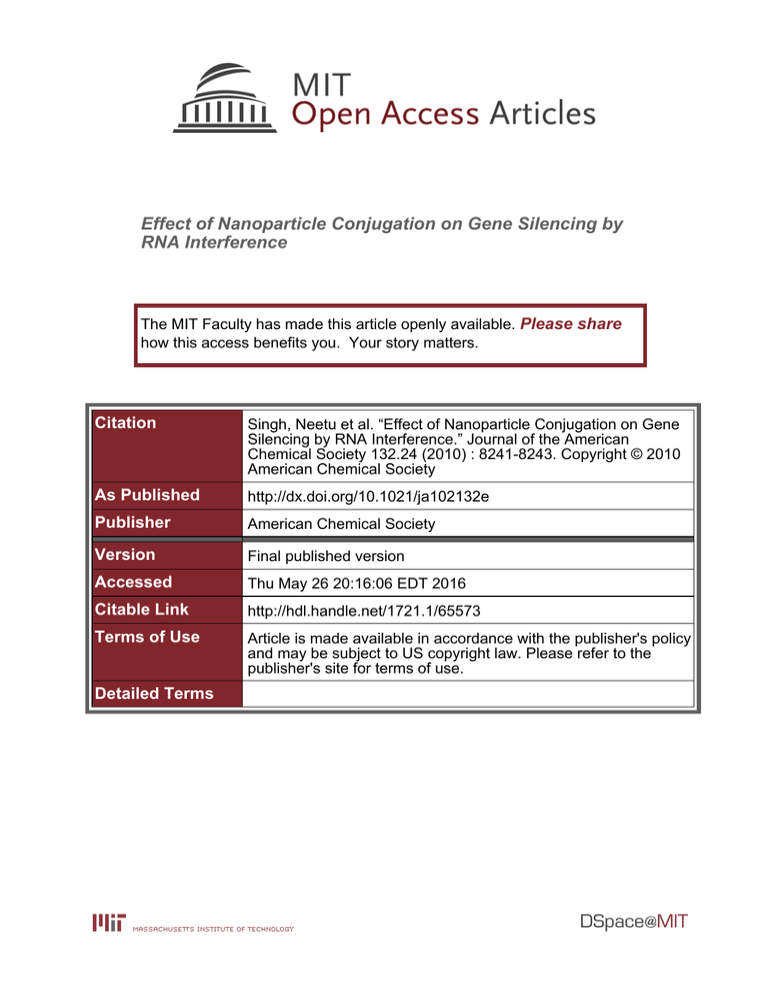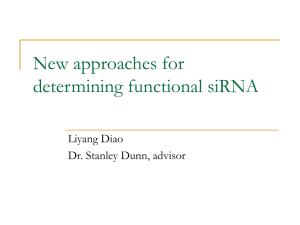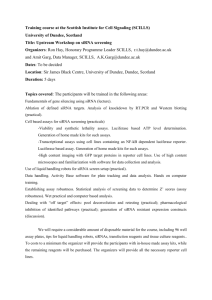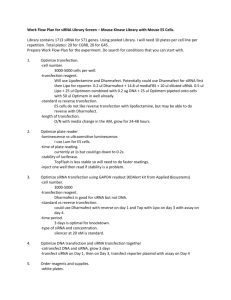Effect of Nanoparticle Conjugation on Gene Silencing by RNA Interference Please share
advertisement

Effect of Nanoparticle Conjugation on Gene Silencing by RNA Interference The MIT Faculty has made this article openly available. Please share how this access benefits you. Your story matters. Citation Singh, Neetu et al. “Effect of Nanoparticle Conjugation on Gene Silencing by RNA Interference.” Journal of the American Chemical Society 132.24 (2010) : 8241-8243. Copyright © 2010 American Chemical Society As Published http://dx.doi.org/10.1021/ja102132e Publisher American Chemical Society Version Final published version Accessed Thu May 26 20:16:06 EDT 2016 Citable Link http://hdl.handle.net/1721.1/65573 Terms of Use Article is made available in accordance with the publisher's policy and may be subject to US copyright law. Please refer to the publisher's site for terms of use. Detailed Terms Published on Web 06/02/2010 Effect of Nanoparticle Conjugation on Gene Silencing by RNA Interference Neetu Singh,† Amit Agrawal,† Anthony K. L. Leung,‡ Phillip A. Sharp,‡,§ and Sangeeta N. Bhatia*,†,‡,|,⊥,# HarVard-MIT DiVision of Health Sciences and Technology, MIT, Cambridge, Massachusetts 02139, The DaVid H. Koch Institute for IntegratiVe Cancer Research, MIT, Cambridge, Massachusetts 02139, Department of Biology, MIT, Cambridge, Massachusetts 02139, Electrical Engineering and Computer Science, MIT, Cambridge, Massachusetts 02139, DiVision of Medicine, Brigham and Women’s Hospital, Boston, Massachusetts 02115, and Howard Hughes Medical Institute, Cambridge, Massachusetts 02139 Received March 12, 2010; E-mail: sbhatia@mit.edu RNA interference (RNAi) is a cellular process whereby the silencing of a particular gene is mediated by short RNAs. One type is mediated by short interfering RNAs (siRNA) in which the antisense strand of a double-stranded RNA duplex guides recognition and catalytic degradation of a target mRNA by the RNAinduced silencing complex (RISC). Another is mediated by endogenous ∼20-25nt short RNAs known as microRNAs (miRNAs) that either repress translation and/or enhance degradation of target mRNAs. There has been tremendous interest in advancing the fundamental understanding of both pathways and harnessing them for therapeutic applications by delivering short RNAs into cells to control gene expression; however this delivery has been challenging.1 To achieve successful gene silencing using siRNA, several key delivery requirements must be met: the siRNA must survive degradation in the extracellular milieu, be transported to the cell surface, cross the cell membrane, and ultimately enter RISC where unwinding and pairing of the antisense strand with native mRNA occur. In ViVo, free siRNA is too rapidly cleared through the kidney to be effective; thus a variety of carriers have been explored that extend its circulation time and aid in trafficking to the site of disease. Over the past decade, systematic investigations by several groups to address this siRNA delivery challenge have started bearing fruit.2–9 A plethora of cationic polymers (including lipids) and nanoparticles (e.g., magnetic, quantum dots, gold and carbohydrate nanoparticles) have been shown to deliver siRNAs resulting in silencing of specific genes both in Vitro and in ViVo.7,10–12 As a result, methods for complexation/conjugation of siRNA with various delivery agents and a better understanding of the delivery process have emerged.10,13 Both charge-charge complexation of cationic polymers with anionic siRNAs and covalent coupling of siRNAs with polymers or nanoparticles have been shown to be effective in delivering siRNAs.10 Nonetheless, reports describing the effects of nanoparticle conjugation on RISC incorporation and subsequent gene silencing have been mixed.14 Moreover, it is unclear how the length of linker between nanoparticle and siRNA, direction of conjugation (3′ vs 5′), and strand used for conjugation (sense vs antisense) affect the relative extent of gene silencing for a given nanoparticle system. For example, a high level of gene silencing was observed in ViVo using a nanoparticle-siRNA conjugate when the antisense strand was conjugated to the nanoparticle Via a thioether nonlabile bond15 while other reports suggest that a labile cross-linker forming a † Harvard-MIT Division of Health Sciences and Technology, MIT. The David H. Koch Institute for Integrative Cancer Research, MIT. Department of Biology, MIT. | Electrical Engineering and Computer Science, MIT. ⊥ Brigham and Women’s Hospital. # Howard Hughes Medical Institute. ‡ § 10.1021/ja102132e 2010 American Chemical Society Figure 1. Probing the effect of conjugation strategy on gene silencing by QD-siRNA conjugates. (a) Scheme for probe synthesis. (b) Characterization of the probes. (Left) Gel electrophoresis of QD-siRNA conjugates. Conjugation with labile cross-linkers (SPDP and SMPT) releases the conjugated siRNA upon treatment with glutathione. Arrow indicates free siRNA. (Middle) Gel electrophoresis of QD-siRNA with nonlabile maleimide cross-linker indicating the absence of unbound siRNA. (Right) Intracellular delivery of QD-siRNA conjugates by electroporation in modified HeLa (GFP-Ago2/Luc-CXCR4) cells. QD-siRNA conjugates are in red, green is Ago2-GFP, and the nuclei are stained with DAPI (blue). Scale bar is 30 µm. disulfide bond leads to greater silencing in comparison with a nonlabile amide bond forming cross-linker.16 In another report, Dai et al. showed that a labile disulfide bond based carbon nanotubesiRNA conjugate leads to greater gene silencing in comparison with a nonlabile nanotube-siRNA conjugate.17 Elsewhere, it has been reported that chemical modification of the 5′- terminus of the antisense strand can limit RNAi activity.18,19 Still, nanoparticles conjugated with the 5′ antisense end of siRNA have been shown to cause effective gene silencing.7,15 To reconcile these seemingly disparate findings, we embarked on a systematic evaluation of siRNA coupling strategies using a single nanoparticle system, cell type, and target gene. Here, we present a systematic study utilizing a single nanoparticle system to investigate the effect of siRNA-nanoparticle conjugation on gene silencing (Figure 1a). We studied gene knockdown (KD) by siRNAs that are covalently coupled to the surface of a nanoparticle Via their sense or antisense strand using a labile (Figure 1a, I and II) or nonlabile (Figure 1a, III-V) cross-linker of varying lengths. We chose quantum dots as a model nanoparticle system J. AM. CHEM. SOC. 2010, 132, 8241–8243 9 8241 COMMUNICATIONS due to their excellent photoluminiscent properties providing the ability to be monitored Via optical imaging.20 The sense strand (SsiRNA) or the antisense strand (As-siRNA) of thiol-modified siRNAs was coupled with the amines on QD655-PEG-NH2 Via labile disulfide forming sulfosuccinimidyl 6-(3′-[2-pyridyldithio]propionamido) hexanoate (SPDP) and sulfosuccinimidyl 6-[Rmethyl-R-(2-pyridyldithio)toluamido] hexanoate (SMPT) or Via nonlabile thioether forming succinimidyl-[(N-maleimidopropionamido)-nethylene glycol] ester (NHS-PEOn-Maleimide). After conjugation the QD-siRNA conjugates were purified and analyzed for siRNA release, purity, and cytosolic distribution (Figure 1b). To ensure the release of siRNAs from the nanoparticles conjugated Via labile cross-linkers, the conjugates were incubated in a glutathione concentration (10 mM) similar to intracellular levels and analyzed by gel electrophoresis. Glutathione was able to release siRNA from nanoparticles that had labile SPDP and SMPT as crosslinkers (Figure 1b, left). On the other hand, the nanoparticles with nonlabile maleimide cross-linkers (QD-4-Mal, QD-12-Mal, and QD24-Mal) did not release the siRNA (Figure 1b, left) irrespective of the conjugation site (Figure 1b, middle). The amount of siRNA on the nanoparticles was quantified for all the samples by SYBR gold staining. The conjugation resulted in ∼3 siRNA per QD nanoparticle. The purity of the samples (free of unbound siRNA) was confirmed by electrophoretic, UV, and gene KD experiments (Figure 1b and Supporting Information). The nanoparticle conjugates were delivered to the cytosol of modified HeLa cells (stably transfected with GFP-Ago2/LucCXCR4) by electroporation to avoid membrane interactions. Electroporation resulted in an association with most cells and a cytosolic distribution as observed by epifluorescent microscopy (Figure 1b, right). It has been shown earlier by our group that electroporation can be an efficient delivery scheme for QD conjugates into the cytosol without the loss of surface ligands.21 The modified HeLa cell line stably expressing GFP-Ago2 and Renilla luciferase allowed testing the siRNA activity Via two RNAi pathways: miRNA-mediated repression and siRNA-mediated catalytic cleavage of the targeted transcript. To examine the miRNA pathway, the 3′ untranslated region of the luciferase was modified by insertion of two partially complementary binding sites for a specific siRNA, siCXCR4 (Figure 1a, siRNA activity reporter). Functioning like an endogenous miRNA, the siCXCR4 binds in a bulged configuration, resulting in translational suppression and mRNA degradation of the targeted transcript.22,23 On the other hand, a siRNA targeting the coding region of the luciferase, siLuc, was used to examine the efficiency in siRNA-mediated cleavage of the targeted transcripts in the same cell line. The degree of KD was assessed through luciferase activity after 48 h. QDs with siRNA conjugated Via labile cross-linkers SPDP (Figure 2a) and SMPT (Figure 2b) were able to KD the luciferase gene with high efficiency (>90%). This is probably due to release of siRNA from the nanoparticle driven by cleavage of the labile bond in the reducing intracellular environment24 making siRNA available for incorporation into the RISC complex, which results in efficient gene KD consistent with the observation of Dai and co-workers with hydrophobic carbon nanotubes.17 On the other hand, use of a short nonlabile cross-linker resulted in poor gene KD (Figure 2c) similar to what was observed by our group previously.16 This is likely due to poor availability of siRNA for the RISC complex, driven by the steric hindrance of a large nanoparticle. We hypothesized that a longer tether may alleviate the steric hindrance and improve accessibility of siRNA on a nanoparticle. In a comparison of maleimide cross-linkers with a spacer arm length of 24.6 Å (PEO-4-Mal), 53.4 Å (PEO-12-Mal), 8242 J. AM. CHEM. SOC. 9 VOL. 132, NO. 24, 2010 Figure 2. KD of luciferase by QD-siRNA conjugates with antisense (As) or sense (S) strand of siLuc and siCXCR4 conjugated (n ) 3). KD by QDsiRNA conjugates with labile (a) SPDP, (b) SMPT, and short nonlabile (c) PEO-12-Mal. KD by nonlabile cross-linker of varying length (d) PEO-4Mal, (e) PEO-12-Mal, (f) PEO-24-Mal. and 95.2 Å (PEO-24-Mal), increasing the chain length improved the gene silencing efficiency from undetectable levels of KD for QD-4-Mal-siRNA (Figure 2d) to ∼30% for QD-12-Mal-siRNA (Figure 2e) and finally to >90% for QD-24-Mal-siRNA (Figure 2f). Thus, nonlabile cross-linkers can provide comparable efficiencies to labile cross-linkers under certain circumstances. In comparing the effects of strand orientation, we found that luciferase activity was knocked down equivalently irrespective of whether the antisense or sense strand of siRNA was attached to the QD surface (Figure 2), suggesting that conjugation to the QD has little inhibitory effect on siRNA activity and that the site of conjugation may not be critical, which was also observed by Moore and co-workers with a different nanoparticle system.15 Thus, having the sense strand conjugated and the antisense strand hybridized (thus easily released) does not offer a significant advantage over having the antisense strand conjugated and sense strand hybridized. Rather, the stability of the cross-linking bond and tether length were the dominant determinants of knockdown efficiency. For in ViVo applications, reducing agents in the bloodstream can release siRNA from the nanoparticle even before siRNA-nanoparticle conjugates are able to reach the cells. This would reduce the extent of KD due to low amounts of siRNA targeted to cells. Therefore, we investigated the stability (against disulfide bond reduction) and gene silencing efficiency of the siRNA-nanoparticle conjugates with the labile (SPDP and SMPT) and the longer nonlabile (PEO-24-Mal) cross-linker after exposure to serum. The siRNA-nanoparticle conjugates were incubated in 10% fetal bovine serum (FBS) and purified Via filtration to remove free siRNA (released from the nanoparticle surface by serum). The purified nanoparticle conjugates were then analyzed by gel electrophoresis (Figure 3a) for the amount of siRNA that remained on the nanoparticle surface. After 8 h, all of the siRNA was released (by serum) from the QD-siRNA conjugates with labile cross-linkers SPDP and SMPT, as further treatment with glutathione did not release any COMMUNICATIONS case. These findings were independent of the strand orientation. While our findings may be specific to a surface chemistry, target mRNA, and cell line, we believe these data provide a useful framework that can be used to guide siRNA conjugation strategies across different model systems to achieve efficient gene silencing. Acknowledgment. We acknowledge financial support from the NIH through Grants R01-CA124427, U54-CA119349, and U54CA119335. S.N.B. is an HHMI Investigator. A.A. acknowledges support from David H. Koch Cancer Research Fund. This work was also supported by Grants RO1-CA133404 (NIH), PO1CA42063 (NCI) to P.A.S. and partially by Grant P30-CA14051 (NCI). A.K.L.L. is a special fellow of the Leukemia and Lymphoma Society. We thank Lourdes Aleman for providing the cell line, Eliza Vasile (Microscopy core facilities KI, MIT) for help with imaging, and Alnylam for synthesizing the siRNAs. Supporting Information Available: Experimental details and figures. This material is available free of charge via the Internet at http:// pubs.acs.org. References Figure 3. Performance of QD-siRNA conjugates with different conjugation chemistries after incubation in 10% FBS at 37 °C. (a) Gel electrophoresis of QD-siRNA showing the loss of siRNA after 8 h when conjugated with a labile cross-linker. (b) Comparison of the luciferase KD efficiency by QD-siRNA conjugates after incubation in 10% FBS. siRNA. The release in serum was faster for the SPDP cross-linker (4 h) in comparison to SMPT (8 h), which is expected due to the less stable disulfide bond in SPDP. We analyzed the KD efficiency after incubating the conjugates for 8 h in 10% FBS and then removing the free siRNA from the samples. We observed that the QD-siRNA conjugates with labile cross-linkers (SPDP and SMPT) lost their KD efficiency after 8 h, whereas the conjugate with the nonlabile cross-linker (PEO-24-Mal) was able to maintain its activity and ability to efficiently KD luciferase (Figure 3b). Thus, nonlabile cross-linkers offer improved stability of the nanoparticle conjugates and do not compromise the KD efficiency as long as they are long enough to allow siRNA-RISC interaction without steric hindrance from the nanoparticle. In conclusion, using a single nanoparticle system with varying conjugation schemes and model cell line, we have shown that the accessibility of the siRNA linked to the nanoparticle may be critical for efficient gene KD mediated by both siRNA and miRNA pathways. In this model system, the efficiency of KD is governed by the conjugation strategy (labile vs nonlabile) used for attaching the siRNA to the nanoparticle and the tether length in the nonlabile (1) de Fougerolles, A.; Vornlocher, H.-P.; Maraganore, J.; Lieberman, J. Nat. ReV. Drug DiscoV. 2007, 6, 443–453. (2) Agrawal, A.; Min, D.-H.; Singh, N.; Zhu, H.; Birjiniuk, A.; von Maltzahn, G.; Harris, T. J.; Xing, D.; Woolfenden, S. D.; Sharp, P. A.; Charest, A.; Bhatia, S. ACS Nano 2009, 3, 2495–2504. (3) Giljohann, D. A.; Seferos, D. S.; Prigodich, A. E.; Patel, P. C.; Mirkin, C. A. J. Am. Chem. Soc. 2009, 131, 2072–2073. (4) Lee, J.-H.; Lee, K.; Moon, S. H.; Lee, Y.; Park, T. G.; Cheon, J. Angew. Chem., Int. Ed. 2009, 48, 4174–4179. (5) Lee, J.-S.; Green, J. J.; Love, K. T.; Sunshine, J.; Langer, R.; Anderson, D. G. Nano Lett. 2009, 9, 2402–2406. (6) Namiki, Y.; Namiki, T.; Yoshida, H.; Ishii, Y.; Tsubota, A.; Koido, S.; Nariai, K.; Mitsunaga, M.; Yanagisawa, S.; Kashiwagi, H.; Mabashi, Y.; Yumoto, Y.; Hoshina, S.; Fujise, K.; Tada, N. Nat. Nanotechnol. 2009, 4, 598–606. (7) Nishina, K.; Unno, T.; Uno, Y.; Kubodera, T.; Kanouchi, T.; Mizusawa, H.; Yokota, T. Mol. Ther. 2008, 16, 734–740. (8) Yagi, N.; Manabe, I.; Tottori, T.; Ishihara, A.; Ogata, F.; Kim, J. H.; Nishimura, S.; Fujiu, K.; Oishi, Y.; Itaka, K.; Kato, Y.; Yamauchi, M.; Nagai, R. Cancer Res. 2009, 69, 6531–6538. (9) Yezhelyev, M. V.; Qi, L.; ORegan, R. M.; Nie, S.; Gao, X. J. Am. Chem. Soc. 2008, 130, 9006–9012. (10) Jeong, J.; Mok, H.; Oh, Y. K.; Park, T. G. Bioconjugate Chem. 2009, 20, 5–14. (11) Whitehead, K. A.; Langer, R.; Anderson, D. G. Nat. ReV. Drug DiscoV. 2009, 8, 129–138. (12) Dalby, B.; Cates, S.; Harris, A.; Ohki, E. C.; Tilkins, M. L.; Price, P. J.; Ciccarone, V. C. Methods 2004, 33, 95–103. (13) Juliano, R.; Alam, M. R.; Dixit, V.; Kang, H. Nucleic Acids Res. 2008, 342. (14) Ameres, S. L.; Martinez, J.; Schroeder, R. Cell 2007, 130, 101–112. (15) Medarova, Z.; Pham, W.; Farrar, C.; Petkova, V.; Moore, A. Nat. Med. 2007, 13, 372–377. (16) Derfus, A. M.; Chen, A. A.; Min, D.-H.; Ruoslahti, E.; Bhatia, S. N. Bioconjugate Chem. 2007, 18, 1391–1396. (17) Kam, N. W.; Liu, Z.; Dai, H. J. Am. Chem. Soc. 2005, 127, 12492–3. (18) Chiu, Y. L.; Rana, T. M. RNA 2003, 9, 1034–48. (19) Prakash, T.; Allerson, C. R.; Dande, P.; Vickers, T. A.; Sioufi, N.; Jarres, R.; Baker, B. F.; Swayze, E.; Griffey, R. H.; Bhat, B. J. Med. Chem. 2005, 48, 4247–53. (20) Akerman, M. E.; Chan, W. C.; Laakkonen, P.; Bhatia, S. N.; Ruoslahti, E. Proc. Natl. Acad. Sci. U.S.A. 2002, 99, 12617–21. (21) Derfus, A. M.; Chan, W. C. W.; Bhatia, S. N. AdV. Mater. 2004, 16, 961– 966. (22) Doench, J. G.; Petersen, C. P.; Sharp, P. A. Genes DeV. 2003, 17, 438–42. (23) Aleman, L. M.; Doench, J.; Sharp, P. A. RNA 2007, 13, 385–95. (24) Wang, W.; Ballatori, N. Pharmacol. ReV. 1998, 50, 335–356. JA102132E J. AM. CHEM. SOC. 9 VOL. 132, NO. 24, 2010 8243






